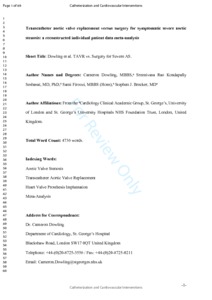Dowling, C; Kondapally Seshasai, SR; Firoozi, S; Brecker, SJ
(2020)
Transcatheter aortic valve replacement versus surgery for symptomatic severe aortic stenosis: A reconstructed individual patient data meta-analysis.
Catheter Cardiovasc Interv, 96 (1).
pp. 158-166.
ISSN 1522-726X
https://doi.org/10.1002/ccd.28504
SGUL Authors: Brecker, Stephen
![[img]](https://openaccess.sgul.ac.uk/111271/1.hassmallThumbnailVersion/TAVR%20vs%20surgery%20for%20symptomatic%20severe%20AS%20-%20A%20reconstructed%20IPD%20meta-analysis.pdf)  Preview |
|
PDF
Accepted Version
Available under License ["licenses_description_publisher" not defined].
Download (4MB)
| Preview
|
Abstract
OBJECTIVES: We wished to undertake a reconstructed individual patient data meta-analysis of randomized clinical trials comparing transcatheter aortic valve replacement (TAVR) and surgery for patients with severe symptomatic aortic stenosis. BACKGROUND: TAVR and surgery are both well-established methods for treating patients with symptomatic severe aortic stenosis who are at low, intermediate, and high risk for surgery. METHODS: Data were identified by searches of Medline, Embase, CENTRAL and ClinicalTrials.gov for all randomized clinical trials, which compared TAVR and surgery that had published at least 1 year of follow-up. Individual patient data were reconstructed from Kaplan-Meier curves. RESULTS: A total of 7,770 patients from seven randomized clinical trials were included in this meta-analysis. At 1 year, TAVR was associated with a lower risk of death from any cause (hazard ratio [HR], 0.85, 95% confidence interval [CI], 0.73-0.98; p = .03), disabling stroke (HR, 0.71; 95% CI, 0.54-0.93; p = .01) and the composite end point of death or disabling stroke (HR, 0.79; 95% CI, 0.67-0.92; p = .002). Significant interactions were found for access suitability, with TAVR associated with a lower risk of these end points in patients suitable for transfemoral access. TAVR was associated with a lower risk of periprocedural events, whereas the risk of late events was similar between TAVR and surgery. CONCLUSIONS: At 1 year, TAVR was associated with a lower risk of death, disabling stroke and the composite end point, when compared with surgery. These associations were strongest within the subgroup of patients in whom transfemoral access was feasible.
| Item Type: |
Article
|
| Additional Information: |
This is the peer reviewed version of the following article: Dowling, C, Kondapally Seshasai, SR, Firoozi, S, Brecker, SJ. Transcatheter aortic valve replacement versus surgery for symptomatic severe aortic stenosis: A reconstructed individual patient data meta‐analysis. Catheter Cardiovasc Interv. 2020; 96: 158– 166, which has been published in final form at https://doi.org/10.1002/ccd.28504. This article may be used for non-commercial purposes in accordance with Wiley Terms and Conditions for Use of Self-Archived Versions. |
| Keywords: |
aortic valve stenosis, heart valve prosthesis implantation, meta-analysis, transcatheter aortic valve replacement, aortic valve stenosis, heart valve prosthesis implantation, meta-analysis, transcatheter aortic valve replacement, Cardiovascular System & Hematology, 1102 Cardiovascular Medicine And Haematology |
| SGUL Research Institute / Research Centre: |
Academic Structure > Molecular and Clinical Sciences Research Institute (MCS) |
| Journal or Publication Title: |
Catheter Cardiovasc Interv |
| ISSN: |
1522-726X |
| Language: |
eng |
| Dates: |
| Date | Event |
|---|
| 11 July 2020 | Published | | 30 September 2019 | Published Online | | 5 September 2019 | Accepted |
|
| Publisher License: |
Publisher's own licence |
| PubMed ID: |
31566902 |
 |
Go to PubMed abstract |
| URI: |
https://openaccess.sgul.ac.uk/id/eprint/111271 |
| Publisher's version: |
https://doi.org/10.1002/ccd.28504 |
Statistics
Item downloaded times since 11 Oct 2019.
Actions (login required)
 |
Edit Item |



